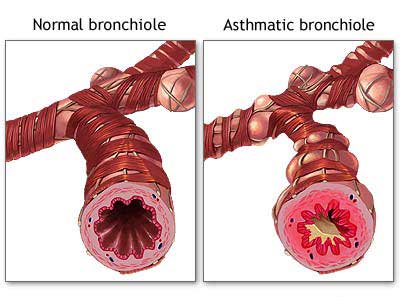Asthma is a chronic lung disease that affects the airways and causes breathing difficulty known as an asthma attack. Reducing asthma attacks not only improves quality of life for the sufferer, it also prevents damage to the lungs. Several factors can be addressed to reduce asthma attacks and prevent some from happening.
Asthma attacks can be reduced by finding out the food allergies and eliminating/reducing their food allergens and supplements that may be used in natural diet.
Asthma can be treated naturally through various steps such as:

- Find out which food allergies you may have through an elimination diet. The most common allergic foods are soy, dairy, citrus, wheat, peanuts, corn, eggs, and shell fish. Remove suspected allergens from your diet for at least a two week period. Slowly re-introduce these foods to your diet at a rate of one every three days. Watch for reactions which may include gastrointestinal upset, mood changes, headaches, and exacerbation of asthma.
- Decrease pro-inflammatory foods in your diet including saturated fats (meats, especially poultry, and dairy), sugar, and refined foods. Antibiotic sensitive people should eat organic meats to avoid antibiotic residues.
- Increase fresh fruits and vegetables, legumes, onions, whole grains, and garlic if there is not sensitivity to these foods.
- Some supplements that help to reduce asthma attacks are vitamin C, B6, magnesium, B12, N-acetyl cysteine, and selenium.
A few steps through which Asthma attacks can be reduced are:
Step 1:
Devise a treatment plan with your doctor. This includes considering medicines to take daily, emergency drugs and how often checkup appointments should be scheduled.

Step 2:
Know asthma attack warning signals. Catching a flare-up before it becomes an actual asthma attack reduces stress on the body as well as the emotional toll taken by dealing with an attack.
Step 3:
Avoid triggers. Many strong smells and chemicals are known irritants for asthma sufferers. Keeping a journal of what was around before an attack can also aid in identifying triggers.
Step 4:
Get tested for allergies. Once triggers are known, they can be avoided. Allergy shots can be created based on these test results, and these can be extremely helpful if allergies are a problem.
Step 5:
Exercise. This helps the lungs by working them out. Make sure to get clearance from the doctor before beginning, and don’t overdo it.
Step 6:
Keep the air inside clean. Air purifiers, frequent cleaning and vacuuming and special air filters all help keep the air inside a home clear of allergens. Special covers for bedding can help keep dust from sticking around.